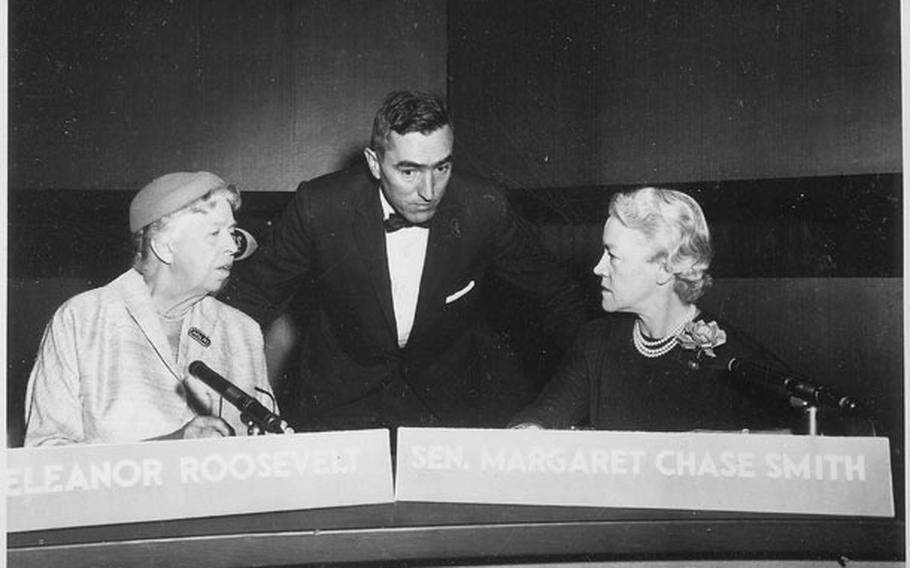
Eleanor Roosevelt, left, and Margaret Chase Smith at the first televised presidential debate on Nov. 4, 1956. (National Archives and Records Administration)
Against the backdrop of war in the Middle East and the Russian invasion of a neighboring state, two prominent American politicians met for a presidential debate ahead of the November election.
Both were women.
The joint appearance on CBS’s “Face the Nation” by Democratic doyenne Eleanor Roosevelt and Sen. Margaret Chase Smith (R-Maine) on Nov. 4, 1956, is widely regarded as the first televised presidential debate.
Roosevelt and Smith served as surrogates for Democratic challenger Adlai Stevenson and Republican President Dwight D. Eisenhower, four years before John F. Kennedy and Richard M. Nixon would hold a much more famous televised debate, the first between presidential candidates.
More than a decade after the death of her husband, President Franklin D. Roosevelt, Eleanor Roosevelt remained an influential figure in the Democratic Party and a prominent ally of Stevenson, the former governor of Illinois who had run against Eisenhower four years earlier. Smith had made national headlines in 1950 when she delivered a “declaration of conscience” on the Senate floor denouncing the anti-communist tactics of Sen. Joseph McCarthy (R-Wis.), earning praise and sparking speculation that she could become a vice-presidential candidate.
With its collection of white male questioners and patronizing introduction of Roosevelt and Smith as “charming ladies,” the half-hour broadcast exemplified the social mores of the black-and-white TV era. But the serious issues that confronted the presidential surrogates remain familiar to Americans in the 21st century and are likely to come up during Thursday night’s debate between President Biden and Donald Trump.
The broadcast came as Britain and France prepared to take control of the Suez Canal following Israel’s invasion of Egypt in late October. As the specter of war darkened the Middle East, Soviet troops rolled into Hungary to crush an uprising against the Kremlin-backed communist regime in Budapest.
From the outset, Roosevelt dominated the debate. “When there was silence to be filled,” Smith biographer Janann Sherman wrote, “Mrs. Roosevelt filled it.”
Roosevelt blamed the Eisenhower administration for failing to act to prevent the burgeoning Middle East conflict. “We did not move soon enough,” she said. “We were partly held back by our oil interests. But these things don’t happen overnight. They build up. And I think anyone who has watched the situation in the Middle East growing has been longing to see some kind of constructive action on the part of the administration.”
Events in the Middle East and Eastern Europe were linked, Roosevelt said. “There wouldn’t have been an aggression in Hungary” if the United States had taken a stronger stand in the Middle East, she said.
Smith succinctly defended the administration’s handling of the crisis. “I think President Eisenhower has done his level best to get Israel to quiet down, to have Egypt go along in a peaceful way,” she said.
Asked by Chicago Daily News diplomatic correspondent Peter Lisagor whether the U.S. leadership could have prevented war in the Middle East, Smith responded, “No, I don’t think it could have.”
Smith’s brevity was strategic. She wrote in her autobiography that she and longtime aide Bill Lewis settled on a plan to highlight her contrasts with Roosevelt whenever possible. With the former first lady’s capacity for speaking with “conviction and an impressive tone of authority,” Smith decided to keep her answers short and to the point.
“This, of course, entailed a risk: as a good debater, Mrs. Roosevelt might dominate the debate and I could look weak in contrast,” Smith conceded. “But I preferred this risk to laboring answers and overextending myself to the point of vulnerability.”
Smith wrote that she wore a dark dress with a strand of pearls and her trademark red rose for a sharper image on black-and-white TV and to contrast with what she and Lewis guessed Roosevelt would be wearing. Roosevelt arrived in a beige suit and wore a hat.
Smith and Lewis wanted the debate to conclude with two-minute closing statements and threatened to back out of the broadcast when they were told shortly before airtime that there was no time for summations. The network brass acceded, and closing statements were kept.
Roosevelt concluded with a denunciation of the administration’s position on atmospheric hydrogen bomb tests and defended Stevenson’s call for an end to the draft.
When it was her turn, Smith took the gloves off. She cited her record of opposing the smear tactics employed by McCarthy against Democrats and offered a pointed defense of Eisenhower.
“Democratic presidents, together with leaders of our allies, chose Dwight D. Eisenhower to lead our nations to victory in World War II and to head up NATO to stop the spread of communism,” she added. “It’s strange to see and hear Democratic leaders now accusing him of not being a leader. Why the difference? It is clearly the difference between principles and politics.”
Roosevelt was aghast.
“When Senator Smith reached over to shake hands with Mrs. Roosevelt, the first lady pulled away, turned her back, and said to her companions as she walked away, ‘Did you hear what she said?’” Lewis wrote in an editor’s note in Smith’s autobiography.
Her irritation with Smith may have been nothing more than exhaustion. “The last few days of the campaign were really strenuous and I was getting mighty tired of the sound of my own voice,” Roosevelt recalled in her autobiography.
Or it might have reflected an awareness that she was fighting an uphill battle for the Democratic candidate. On Election Day, Eisenhower cruised to a second term with 457 electoral votes and 57 percent of the popular vote.